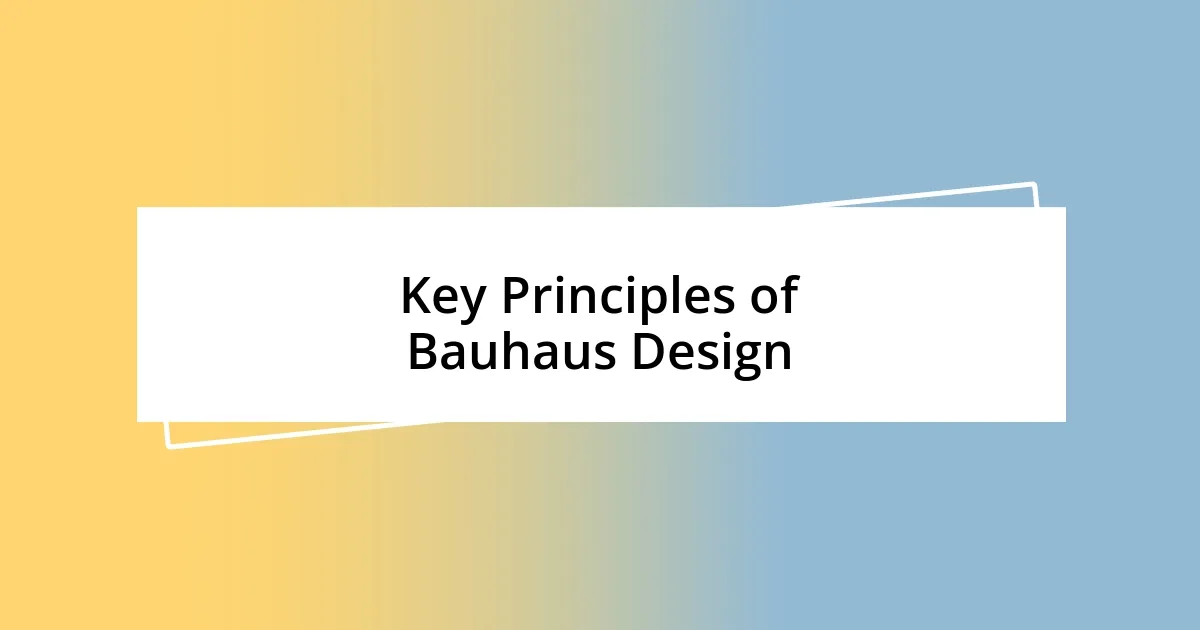Key takeaways:
- The Bauhaus school, founded in 1919 in Germany, revolutionized design by merging art, craft, and technology, fostering interdisciplinary collaboration.
- Key principles of Bauhaus design include “form follows function,” simplicity, and honest use of materials, influencing modern architecture and design practices.
- The school’s emphasis on hands-on education and experimentation led to innovative design solutions, encouraging critical thinking and questioning traditional norms.
- Bauhaus ideas continue to impact contemporary art movements through minimalism and collaborative practices, demonstrating the enduring relevance of its principles.

History of the Bauhaus School
The Bauhaus school, founded in 1919 in Weimar, Germany, emerged as a revolutionary force in the world of design and architecture. I remember first hearing about its impact during a design course; the thought of combining art, craft, and technology genuinely piqued my curiosity. Was it possible to create a harmonious blend of function and beauty? The Bauhaus answered that question with a resounding yes, fostering an environment where interdisciplinary collaboration thrived.
As the school moved to Dessau in 1925, it began to gain international recognition, attracting influential artists and designers like Paul Klee and Wassily Kandinsky. It’s fascinating to think about how their innovative ideas were nurtured in such a vibrant setting. I often wonder; how did this melting pot of creativity shape the very fabric of modern design? The Bauhaus wasn’t just a place of learning; it became a crucible for radical ideas that redefined art and architecture.
Eventually, political changes led to the school’s closure in 1933, but its legacy endured far beyond its brief existence. I often reflect on this bittersweet ending—how a school that sparked a movement had to contend with such tumultuous times. The story of the Bauhaus reminds me that innovation often arises from adversity, leaving an indelible mark on countless fields.

Key Principles of Bauhaus Design
When I first explored the key principles of Bauhaus design, I was struck by the emphasis on simplicity and functionality. It made me rethink how I perceive everyday objects. The idea that elegance can arise from essential elements resonates deeply with me. I often find myself gravitating towards designs that embody this philosophy, appreciating how each component serves a purpose while contributing to a cohesive aesthetic.
The foundational principles of Bauhaus can be summarized in the following points:
- Form Follows Function: This principle emphasizes that the shape of a building or object should be primarily based upon its intended function.
- Simplicity: Bauhaus design advocates for a clean and uncluttered aesthetic, stripping away any unnecessary ornamentation.
- Interdisciplinary Approach: The school promoted collaboration across various fields, merging art, architecture, and crafts seamlessly.
- Integration of Technology: It harnessed modern industrial techniques to create designs that were accessible and functional for everyday life.
- Emphasis on Materials: Bauhaus emphasized using materials honestly, allowing the true nature of wood, metal, and glass to shine through in design.
Delving into these principles has allowed me to appreciate the intentionality behind each design choice. It’s fascinating how these concepts not only shaped physical objects but also influenced broader cultural narratives around modernism.

Influence on Modern Architecture
The Bauhaus school’s influence on modern architecture is undeniable. It introduced the idea of functionality merging with aesthetics, which I remember appreciating during various architectural discussions. I can still see the awe on my peers’ faces when we visited stark, minimalist buildings inspired by Bauhaus principles, marveling at their practicality and elegance. It made me realize that architecture was evolving beyond decorative forms to embrace an authentic expression of needs.
Another fascinating aspect is how the Bauhaus challenged traditional architectural norms. For instance, the use of industrial materials like steel and glass became a hallmark of modernist structures. Reflecting on my experiences, I recall standing in a contemporary museum where large glass panels created a sense of openness, fundamentally altering how I interacted with the space. I couldn’t help but admire how those features rooted in Bauhaus thinking encouraged such freedom and lightness in design.
Lastly, the collaborative spirit of the Bauhaus remains a cornerstone of architectural practice today. It’s inspiring to think about how the teamwork of artists and craftspeople led to innovative solutions that still resonate in modern projects. I often find myself facilitating group projects, which echo that same synergy. The way ideas bounce off each other in a team is invigorating—it’s a reminder that some of the best design solutions come from diverse backgrounds coming together.
| Feature | Bauhaus Influence |
|---|---|
| Functionality | Promoted designs that are useful and efficient. |
| Materials | Emphasized honest use of materials, making structures feel authentic. |
| Collaboration | Encouraged interdisciplinary teamwork, leading to innovative designs. |

Bauhaus and Functional Aesthetics
The concept of functional aesthetics truly captivated me during my exploration of Bauhaus. I remember visiting a furniture exhibition where every piece encapsulated this principle. The chairs didn’t just look good—they felt comfortable and served their purpose flawlessly. It made me wonder how often we overlook functionality in our choices. Shouldn’t our environments enhance our lives in meaningful ways?
What struck me is how Bauhaus products looked deceptively simple. I recall an instance where I used a sleek, minimalist lamp that seemed almost too plain at first glance but transformed the whole atmosphere of my workspace. It was a reminder that every design choice communicates something. I often think about how crucial it is for designs to be intuitive and relatable. After all, isn’t it delightful when function aligns seamlessly with style?
A pivotal moment for me came while trying to declutter my living space. I decided to apply the Bauhaus philosophy and let go of items that served no real purpose. In doing so, I discovered a newfound appreciation for the few objects I retained. It’s enlightening to realize that the beauty of design lies not in excess but in the clarity of purpose. Isn’t it interesting how the principles of Bauhaus can help us not only design our spaces but also curate our lives?

Learning from Bauhaus Teaching Methods
The Bauhaus teaching methods embraced experimentation as a core component of the learning process. I vividly remember my first workshop where we were encouraged to use unconventional materials. That day, we built sculptures from discarded items. It felt liberating to let my creativity run wild—who knew that a broken chair leg could become a stunning focal point? This experience opened my eyes to how the willingness to experiment and explore can lead to unexpected yet beautiful outcomes.
What I find particularly compelling is how Bauhaus emphasized a hands-on approach to education. During a project, I was tasked with designing a space that balanced form and function. I spent countless hours sketching, building models, and refining details. The iterative process taught me that design isn’t just about the final product; it’s about the journey and the learning that happens along the way. Have you ever engaged in a project where the process taught you more than you initially expected?
Moreover, the Bauhaus philosophy promoted critical thinking and questioning the status quo. I recall a discussion we had on the meaning of beauty in design, and it challenged my preconceived notions. This questioning mindset has become invaluable in my career. It reminds me to never settle for the obvious and to dig deeper into the “why” behind design choices. Isn’t it refreshing to approach learning with curiosity, constantly seeking to expand one’s understanding?

Integrating Bauhaus Ideas Today
Integrating Bauhaus ideas today can truly reshape our design practices. I remember when I began redesigning my home office. Leaning on the Bauhaus principle of merging art and function, I chose a desk that was not only visually striking but catered to my workflow. The result? A space that wasn’t just aesthetically pleasing but fostered creativity and productivity—reminding me of how every element can be harmonious.
One particularly transformative experience was when I applied the Bauhaus focus on materials in a recent DIY project. I found beauty in using raw, unrefined materials instead of opting for overly polished finishes. It felt rewarding to create something that told a story through its imperfections. Have you ever noticed how the texture of materials can evoke different emotions? In my case, it deepened the connection I felt to my workspace, as if my surroundings understood my creative journey.
Another way I integrate Bauhaus concepts is by prioritizing simplicity in my design choices. I often find myself reflecting on the clutter of modern life; a minimalist approach has worked wonders for my mental clarity. While curating my bookshelf, I chose only the titles that truly resonated with me. This experience made me question: how can we strip away the excess to appreciate what we truly need? Adopting this Bauhaus mindset not only enhances our environments but encourages a more intentional way of living.

Impact on Contemporary Art Movements
The influence of the Bauhaus on contemporary art movements is truly profound. I remember attending an exhibition that showcased modern installations inspired by Bauhaus principles. The stark simplicity and functional beauty of the pieces sparked a realization for me: artists today still embrace that blend of practicality and creativity. Isn’t it fascinating how ideas from nearly a century ago still resonate so deeply?
One striking example is the trend toward minimalism in art and design, which can be traced back to Bauhaus ideologies. I once collaborated with an artist who favored clean lines and a limited color palette, reflecting that essence of less is more. Watching her work evolve reminded me of the Bauhaus belief that simplicity can convey powerful messages. Have you ever seen a piece of art that stopped you in your tracks due to its elegance and restraint? It’s a testament to how these enduring concepts can inspire clarity and depth in modern works.
Moreover, the collaborative ethos of the Bauhaus continues to shape multidisciplinary practices today. In my own experience, I participated in a community art project where painters, sculptors, and digital artists worked alongside one another. It was thrilling to see how the Bauhaus spirit thrives in such collaboration, breaking down barriers between creative disciplines. How often do we miss the opportunity to innovate simply because we stick to traditional forms? Engaging with others can lead to unexpected outcomes, just as the Bauhaus taught us.














